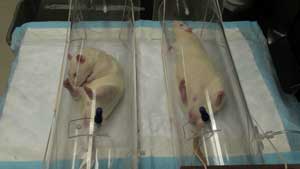Anesthesia is one of the most common surgical practices, and also one of the most mysterious.
In the operating room, doctors have no reliable tools to reverse anesthesia once it starts, because no one understands the neurological mechanisms that switch on consciousness. The only way to pull a patient out of anesthesia is to let the drugs dissipate from the body.
Now, a new study shows that Ritalin — the same drug used to treat attention deficit disorder in children — has the power to wake the brain from general anesthesia. The study, which will appear in the October issue of Anesthesiology, could change the clinical practice of anesthesia and open new pathways to understanding how the brain regains consciousness.
“It’s a major contribution to basic and clinical sciences,” says Bruce MacIver, a professor and neuropharmacology researcher at Stanford School of Medicine. MacIver was not involved in the study. “The possible clinical applications, in terms of patient safety and efficiency, are exciting.”
Overriding the Effects of Anesthesia
In the study, researchers at Massachusetts General Hospital looked at the effects of Ritalin on anesthetized rats. The rats were placed in custom-built gas chambers that were then pumped with isuflorane, a common operating room anesthetic. Researchers found that rats given Ritalin intravenously after anesthesia woke up in less than half time it took their counterparts in the control group. Ritalin was even able to wake up rats who were simultaneously receiving a full dose of general anesthetic.
If the same effect is observed in humans, doctors could gain a new tool to wake up patients from anesthesia. Such a tool could lead to faster recovery times and serve as a “rescue drug” for situations when a patient under general anesthesia stops breathing.
Every day, some 60,000 Americans undergo general anesthesia. At the beginning of a typical surgery, a strong dose of anesthetics plunges the patient’s brain into a state akin to coma. A cocktail of drugs maintains unconsciousness while surgery takes place. Finally, the drugs are turned off, and respiration clears residual anesthetics from the body. As the brain blinks back to action, the patient swallows, grimaces and opens her eyes.
“Anesthesia has an active beginning. Right now it has a passive ending, and it’s not clear that that’s the right way to do it,” says Emery Brown, a co-author of the study and health sciences professor at MIT and Harvard Medical School. “We’re trying to see if it can have an active ending.”

The passive approach is usually safe, but leaves room for improvement. Wake time from general anesthesia can range from five minutes to over an hour, depending on the strength of the drugs involved, the length of the surgery and the health of the patient. Longer recovery means more time in the hospital, an undesirable outcome for patients and for health costs.

“There’s a huge amount of inefficiency right now with how anesthesia is practiced,” says Ken Solt, an assistant professor at Harvard Medical School and the lead author of the paper. “After surgery is over, the [operating room] is at a standstill-nothing can happen until the patient wakes up from anesthesia. It’s a dead time.”
Anesthesia-related deaths are rare, with estimates ranging from 1 death per 200,000 or 300,000 patients. Nonetheless, in a procedure that requires shutting down major portions of the brain, anestheseologists worry about those moments when patients unexpectedly stop breathing. Especially in out-patient settings, such complications can be dangerous.
“If sedation goes too far, we don’t have a rescue drug,” says Solt. “We’ve all been in those emergency situations. Your biggest worry is getting the patient to breathe.”
In such situations, researchers say, Ritalin stimulates breathing and could quickly pull the brain back from total shutdown. “We can use this drug to give a shot of adrenaline to the brain to bring it back from anesthesia,” says Brown.
New Findings, New Questions
Researchers are also excited about new insights the drug could provide on brain function under anesthesia. Recent studies hint at the complex role of neurotransmitter chemicals, which either arouse or inhibit communication between brain cells. As anesthetic seeps into the brain, it appears to strengthen the inhibitory neurotransmitters, thereby leading parts of the brain to shut down. Conversely, as anesthesia wears off, the arousal pathways reopen and consciousness returns.
The brain is like a vast fiberoptic network, with pathways of arousal and inhibition flashing on and off at the same time. Ritalin stimulates two neurotransmitters that play a major role in arousal, dopamine and norepinephrine. In recent years, doctors have noted that patients who take Ritalin need unusually large doses of anesthetic in order to lose consciousness. Building on those findings, the Massachusetts General study shows that the arousal effects of Ritalin can override the inhibitory effects of general anesthesia.
The study also raises a new set of testable hypotheses on improving anesthesia. Brown and Solt speculate that a faster wake time could help eliminate delirium, which affects up to a third of patients as they emerge from anesthesia. A dose of Ritalin at the end of surgery may even help prevent long-term cognitive problems such as loss of memory and concentration, which affects between 10 and 15 percent of elderly patients after general anesthesia.
The next step is to test the effectiveness of the procedure in human patients. MacIver, the anesthesiologist at Stanford, says that in anesthesia research, rats are usually good predictors of human outcomes. Because Ritalin is already an FDA-approved drug, human trials are likely to proceed quickly, with multiple research teams using the drug to explore aspects of the brain.
Before long, the experience of drifting awake from general anesthesia could be part of medical history.



